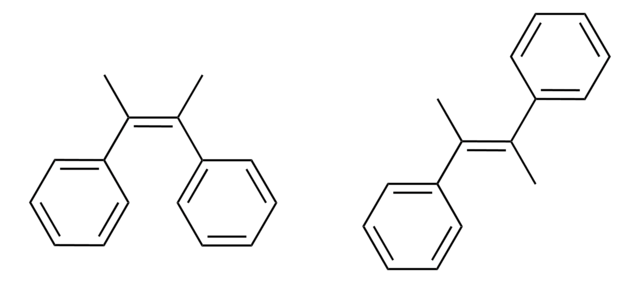725684
Poly(ethylene glycol) dimethacrylate
average MN 10,000, cross-linking reagent polymerization reactions, methacrylate, ≤1, 500 ppm MEHQ as inhibitor (may contain)
Sinônimo(s):
Polyethylene glycol, PEG dimethacrylate
About This Item
Produtos recomendados
product name
Poly(ethylene glycol) dimethacrylate, average Mn 10,000, contains MEHQ as inhibitor
forma
powder
peso molecular
average Mn 10,000
contém
MEHQ as inhibitor
≤1,500 ppm MEHQ as inhibitor (may contain)
adequação da reação
reagent type: cross-linking reagent
reaction type: Polymerization Reactions
pb
>200 °C/2 mmHg (lit.)
temperatura de transição
Tm 56-61 °C
Mw/Mn
≤1.1
Ω-final
methacrylate
α-final
methacrylate
arquitetura do polímero
shape: linear
functionality: homobifunctional
temperatura de armazenamento
−20°C
cadeia de caracteres SMILES
OCCO.CC(=C)C(O)=O
InChI
1S/C10H14O4/c1-7(2)9(11)13-5-6-14-10(12)8(3)4/h1,3,5-6H2,2,4H3
chave InChI
STVZJERGLQHEKB-UHFFFAOYSA-N
Procurando produtos similares? Visita Guia de comparação de produtos
Categorias relacionadas
Nota de preparo
Código de classe de armazenamento
11 - Combustible Solids
Classe de risco de água (WGK)
WGK 1
Certificados de análise (COA)
Busque Certificados de análise (COA) digitando o Número do Lote do produto. Os números de lote e remessa podem ser encontrados no rótulo de um produto após a palavra “Lot” ou “Batch”.
Já possui este produto?
Encontre a documentação dos produtos que você adquiriu recentemente na biblioteca de documentos.
Os clientes também visualizaram
Artigos
Scaffold patterning with poly(ethylene glycol)-based hydrogels for cell presence in 2D and 3D environments on photoactive substrates.
Hydrogel-based biomaterials for cell delivery and tissue regeneration applications are discussed.
In the past two decades, tissue engineering and regenerative medicine have become important interdisciplinary fields that span biology, chemistry, engineering, and medicine.
Progress in biotechnology fields such as tissue engineering and drug delivery is accompanied by an increasing demand for diverse functional biomaterials. One class of biomaterials that has been the subject of intense research interest is hydrogels, because they closely mimic the natural environment of cells, both chemically and physically and therefore can be used as support to grow cells. This article specifically discusses poly(ethylene glycol) (PEG) hydrogels, which are good for biological applications because they do not generally elicit an immune response. PEGs offer a readily available, easy to modify polymer for widespread use in hydrogel fabrication, including 2D and 3D scaffold for tissue culture. The degradable linkages also enable a variety of applications for release of therapeutic agents.
Nossa equipe de cientistas tem experiência em todas as áreas de pesquisa, incluindo Life Sciences, ciência de materiais, síntese química, cromatografia, química analítica e muitas outras.
Entre em contato com a assistência técnica





